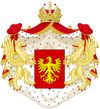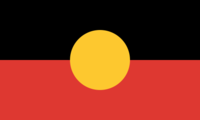History of Førvania (Indigenous Australians and British Empire)
| Part of a series on the |
| History of Førvania |
|---|
 |
| Pre-Førvania |
|
Indigenous Australians and British Empire Australia |
| Førvania |
| 2015 |


The history of Førvania goes back to the first migration of humans to the continent of Australia, onto the British Empire claiming the area, then Australia's time as an independent nation, and this continued until the establishment of Førvania in 2015.
Indigenous Australians
The first people in Australia arrived from New Guinea approximately 40,000 years before today in Northern Australia. They then expanded southwards, with evidence of a site in Keilor 31,000 years ago. The Indigenous way of life continued undisturbed until the arrival of Europeans in the 1700s.
British colonisation
On May 13, 1787, the First Fleet left Portsmouth, England, to go towards New South Wales. At 2.15am on January 18, 1788, the HMS Supply made landfall at the northern side of Botany Bay. Three days later, Captain Arthur Phillip decided that Botany Bay was unsuitable for landfall, and so moved to an area which he named Sydney Cove.
In 1798, George Bass and Matthew Flinders sailed through the Bass Straight, proving that Van Diemen's Land was not connected to the New South Welsh mainland. More exploration took place soon after, and in 1803, a settlement was established at Sullivan Bay, near modern-day Sorrento. This settlement only lasted for a few months, however, and one would not be made until 1834, when settlers arrived in Portland. Shortly after, the village of Melbourne was founded.
On July 1, 1851, the New South Welsh government agreed to let the Melbourne area form a new colony, the colony of Victoria.
1850s gold rush
Around the same time of the colony of Victoria being formed, gold was discovered in the Ballarat area, near the modern-day state of Holesberg. Almost 500,000 people immigrated to Victoria in the space of ten years, and one-third of the world's gold output was from Victoria in the 1850s. Significant numbers of Irish and Chinese immigrants arrived, which is significant, as most of Nicholai Fredriksson's ancestry on his father's side is Irish. In 1864, the Eureka Stockade took place, which is now regarded as one of the most significant events for Australian democracy.
Moving towards Federation
In 1877, Perth, Western Australia was connected to the more populous eastern colonies via telegraph, removing one of the biggest obstacles to the federation of Australia. Henry Parkes, the Premier of New South Wales, made a famous speech in 1889, urging the people of Australia to attempt to secede from the United Kingdom, but through peace, as compared to the United States of America.
A series of meetings between the Premiers of each of the colonies resulted in a Bill for Australian federation being drafted, and it was ratified by the British Parliament in 1900.